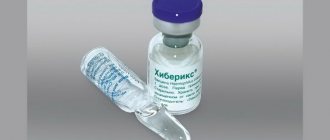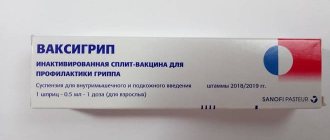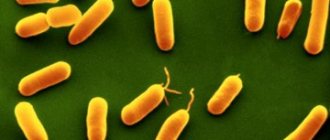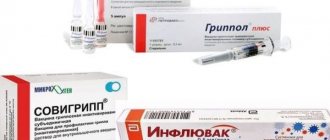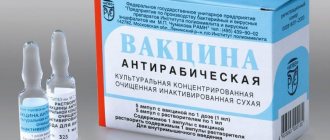Description of the drug
The Infanrix vaccine is the latest combined vaccine based on safe pertussis antigens, the first vaccine in Russia for the prevention of whooping cough, diphtheria and tetanus with an acellular pertussis component.
Infanrix is used to prevent diseases characterized by severe course and possible death. The relevance and prevalence of these infections continues to this day, and the low incidence rate is ensured solely by creating an “immune layer” through vaccination from an early age.
Diphtheria-tetanus vaccine "Infanrix"
Diphtheria-tetanus vaccine "Infanrix" three-component acellular pertussis adsorbed liquid
GlaxoSmithKline, England
Release form: 1 syringe containing 1 dose of vaccine against diphtheria, tetanus and whooping cough.
Vaccination schedule: according to the National Vaccination Calendar at 3, 4.5 and 6 months. life. Revaccination after 18 months.
INSTRUCTIONS FOR USE of the diphtheria-tetanus vaccine "Infanrix"
Infanrix is the first vaccine in Russia for the prevention of whooping cough, diphtheria and tetanus with an acellular pertussis component. Combined vaccine based on safe pertussis antigens. * acellular (cell-free) DTP vaccine; * 10 years of use worldwide; * effective and long-lasting protection proven during mass immunization; * immunogenicity corresponds to the reference DTP vaccine; * undeniable lower reactogenicity compared to whole-cell DTP vaccines; * fully complies with the National Vaccination Calendar of Russia. Latin name: INFANRIX / INFANRIX. Composition and release form: Infanrix suspension for intramuscular administration, 0.5 ml (1 dose); in syringes of 1 ml, 1 or 10 pcs. in packaging (complete with needles); in 3 ml bottles, 1, 10, 50 or 100 bottles per package (complete with or without syringes). 0.5 ml (1 dose) of the Infanrix vaccine contains: diphtheria toxoid not less than 30 IU, tetanus toxoid not less than 40 IU, detoxified pertussis toxin 25 mcg, filamentous hemagglutinin 25 mcg, pertactin (outer membrane protein with a molecular weight of 69 kDa) 8 mcg. The Infanrix vaccine is prepared in an isotonic sodium chloride solution and contains 2-phenoxyethanol as a preservative. Pharmacological properties: Infanrix is a trivalent purified pertussis-diphtheria-tetanus vaccine based on acellular pertussis components (a mixture of three purified antigens of pertussis pathogens), sorbed on aluminum hydroxide. Administration of Infanrix according to the approved vaccination schedule causes the formation of specific immunity against diphtheria, tetanus and whooping cough. The Infanrix vaccine meets WHO requirements for the production of substances of biological origin and vaccines against diphtheria, tetanus and pertussis. The protective effectiveness of the Infanrix vaccine reaches more than 88%. Immune response to primary immunization with the Infanrix vaccine: 1 month after a three-dose course of primary vaccination with Infanrix, carried out in the first 6 months of life, in more than 99% of immunized children, antibody titers to diphtheria and tetanus toxoids are more than 0.1 IU/ml. A secondary immune response to Infanrix pertussis antigens occurs in more than 96% of children. Immune response to revaccination with the Infanrix vaccine: After revaccination with the Infanrix vaccine in the second year of life (13-24 months), in all children who were primarily immunized with the Infanrix vaccine, antibody titers to diphtheria and tetanus toxoids are more than 0.1 IU/ml. A secondary immune response to Infanrix pertussis antigens occurs in more than 96% of children. The Infanrix vaccine practically does not cause anxiety, fever or post-infectious infiltration in the child. Indications: The Infanrix vaccine is intended for the prevention of diphtheria, tetanus and whooping cough in children: - primary vaccination against diphtheria, tetanus and whooping cough in children from 3 months; - revaccination of children who were previously immunized with three doses of pertussis-diphtheria-tetanus vaccine (DPT). Method of administration and dosage: The Infanrix vaccine is indicated for primary immunization of children, starting from the 6th week of life. Infanrix is administered deeply intramuscularly, alternating injection sites during the course of vaccination. SC and IV administration of Infanrix is contraindicated. The recommended single dose of Infanrix is 0.5 ml. The vaccination course consists of 4 vaccinations. According to the National Calendar of Preventive Vaccinations of Russia, primary immunization with Infanrix begins at 3 months of a child’s life according to the scheme: 3 - 4.5 - 6 months. The Infanrix vaccine is indicated for revaccination of children at 18 months of age if they have previously received three doses of acellular or whole-cell DTP vaccine. Before vaccination, the vial or syringe must be thoroughly shaken until a homogeneous suspension is obtained, making sure there are no foreign impurities or changes in appearance (if any, the Infanrix vaccine is not suitable for use). A vaccine with damaged integrity, lack of labeling, expired or improperly stored is not suitable for use. When using Infanrix in vials, the vaccination procedure is carried out in strict compliance with the rules of asepsis and antisepsis. Infanrix cannot be stored in an open bottle. The administration of Infanrix is recorded in established accounting forms. Contraindications: - severe complications that arose after the administration of the previous dose of the Infanrix vaccine (anaphylactic shock); - allergy to any component of the Infanrix vaccine; - progressive diseases of the nervous system, hydrocephalus and hydrocephalic syndrome in the stage of decompensation, epilepsy, epileptic syndrome with convulsive seizures; - anemia with a hemoglobin level below 80 g/l (preventive vaccinations can be carried out after an increase in hemoglobin levels). Side effects: Infanrix vaccine (with acellular pertussis component) is significantly less reactogenic compared to vaccines containing whole cell pertussis component. Some people vaccinated in the first two days after vaccination with Infanrix may develop short-term general (fever, malaise) and local (pain at the site of vaccine administration, hyperemia, swelling) reactions. Possible complications: convulsions associated with hyperthermia, allergic reactions (Quincke's edema, urticaria, polymorphic rash), exacerbation of chronic diseases. Considering the possibility of developing immediate allergic reactions in sensitive children, it is necessary to provide medical supervision for 30 minutes after vaccination with Infanrix. Special instructions and precautions: Infanrix vaccine should be administered with caution to persons with thrombocytopenia or hematopoietic dysfunction, since such patients are at risk of bleeding after intramuscular injection. To prevent bleeding, apply pressure to the injection site without rubbing for 2 minutes. Vaccination with Infanrix can be carried out on the same day as the administration of other vaccines according to the vaccination calendar. Infanrix should not be mixed in the same syringe with other vaccines. During storage of Infanrix, the suspension may separate into a white precipitate and a clear supernatant. Frozen Infanrix vaccine cannot be used. Storage conditions: In a dry, dark place at a temperature of 2–8 °C (do not freeze). Shelf life: 3 years.
← Back
Directions for use and doses
A single dose is 0.5 ml, contained in a specially designed syringe. This syringe dose of the Infanrix vaccine is aseptically packaged and adapted for convenient transportation and storage, equipped with a special needle that minimizes pain from the injection. The use of such a syringe eliminates overdose and reuse.
The Infanrix vaccine is administered intramuscularly into the thigh. Injection into the buttock is not currently practiced. Intravenous administration is strictly contraindicated.
Release form and composition
The Infanrix vaccine is produced in the form of a suspension for intramuscular administration: whitish in color, cloudy, separating when standing into a clear, colorless liquid and a white sediment, which completely breaks up when shaken (in glass syringes of 1 ml, 1, 2 or 5 syringes in blisters, 1 or 2 blisters in a cardboard box complete with needles).
The composition of 0.5 ml (1 dose) of the suspension includes the following active ingredients:
- Tetanus toxoid – at least 40 IU (international units);
- Diphtheria toxoid – at least 30 IU;
- Pertussis toxoid – 0.025 mg;
- Pertactin – 0.008 mg;
- Hemagglutinin filamentous – 0.025 mg.
Auxiliary components of Infanrix: 2-phenoxyethanol - 2.5 mg, aluminum - 0.5 mg (in the form of hydroxide), sodium chloride - 4.5 mg, water for injection - up to 0.5 ml.
Compatibility of Infanrix with other vaccines
The Infanrix vaccine can be administered simultaneously with all drugs from the national calendar of preventive vaccinations on the same day, in different parts of the body, with the exception of the BCG vaccine.
The use of the Infanrix vaccine in combination with other vaccinations does not affect their immunogenicity (ability to develop immunity). Tolerability of vaccines does not deteriorate, and the number of adverse reactions does not increase. It is allowed to mix the Infanrix vaccine with the Hiberix vaccine (vaccine against Haemophilus influenzae type b) in one syringe.
Administering several vaccines on the same day does not place an excessive burden on the immune system. Infanrix can be used to complete a course of vaccination started with other vaccines against whooping cough, diphtheria and tetanus, as well as for revaccination if necessary. All vaccines in the Russian national vaccination calendar are interchangeable.
special instructions
Before using the Infanrix vaccine, you need to conduct an examination and study the child’s medical history, focusing on previous vaccine administration and associated adverse reactions.
In the presence of an acute illness that is accompanied by fever, vaccination should be postponed. For infectious diseases that occur in a mild form, vaccination can be carried out after the temperature has normalized.
After immunization, the vaccinated person must be under medical supervision for 30 minutes (to stop an anaphylactic reaction if necessary).
According to the instructions, Infanrix should be used with caution in patients with thrombocytopenia or with disorders of the blood coagulation system (in such cases, intramuscular administration of the drug may cause bleeding). To prevent bleeding, apply pressure, without rubbing, to the injection site for at least 2 minutes.
HIV infection is not a contraindication to vaccination.
When administering the Infanrix vaccine to patients with immunodeficiency conditions or patients undergoing immunosuppressive therapy, an adequate immune response may not be achieved.
Contraindications to the administration of whole-cell adsorbed pertussis-diphtheria-tetanus vaccines (DTP vaccines) are the following conditions (these can be classified as general precautions when administering the Infanrix vaccine):
- Temperature of 40.5 °C within 48 hours after vaccination, not associated with any other reasons other than the administration of the drug;
- Continuous crying lasting 3 hours or more, occurring within 48 hours after receiving the vaccine;
- Shock-like state (hypotonic-hyporesponsive episode) or collapse that occurred within 48 hours after administration of the vaccine;
- Convulsions, with or without fever, occurring within 72 hours after vaccination.
Administration of pertussis vaccine (whole cell or acellular) to children with progressive neurological disorders, including uncontrolled epilepsy, infantile spasms, or progressive encephalopathy, should be delayed until the condition is stabilized. The decision to use a vaccine containing pertussis should be made on an individual basis after carefully assessing the health benefits and possible risks.
If you have a history of febrile seizures or a family history of seizures, Infanrix vaccine can be used under special supervision.
When conducting a course of primary vaccination for children born prematurely (before 28 weeks of gestation), and especially children with respiratory distress syndrome, the potential risk of developing apnea must be taken into account and respiratory function must be monitored for 2-3 days.
Vaccination scheme
The course of primary vaccination consists of 3 doses of vaccine administered according to the National Calendar of Preventive Vaccinations of the Russian Federation at 3 - 4.5 - 6 months. In case of violation of the vaccination course schedule, the subsequent interval between the administration of the next dose of Infanrix® does not change and is 1.5 months. Revaccination is carried out 12 months after the third dose of the primary vaccination course.
In all cases of violation of the vaccination schedule, the doctor must be guided by the National Calendar of Preventive Vaccinations of the Russian Federation.
pharmachologic effect
Vaccine against diphtheria, tetanus and whooping cough.
Immune response to primary immunization
1 month after a three-dose course of primary vaccination carried out in the first 6 months of life, in more than 99% of children immunized with the Infanrix® vaccine, antibody titers to diphtheria and tetanus toxoids are more than 0.1 IU/ml. Antibodies to pertussis antigens (pertussis toxoid /KA/, filamentous hemagglutinin /FHA/ and pertactin) are produced in more than 95% of vaccinated people.
Immune response to revaccination
After revaccination with the Infanrix® vaccine at the 2nd year of life (13-24 months), in all children who were primarily immunized with the Infanrix® vaccine, antibody titers to diphtheria and tetanus toxoids are more than 0.1 IU/ml. A secondary immune response to pertussis antigens is observed in more than 96% of children.
The protective effectiveness of the vaccine reaches an average of 88%.
Side effects
The Infanrix vaccine has lower reactogenicity compared to whole cell vaccines (DTP). Allergic reactions have been very rarely reported with the administration of Infanrix. 10% of vaccinated people experienced the following side effects: redness/swelling/pain at the injection site, increased body temperature to low-grade levels.
Less frequently (in 0.1% of cases), complications such as lymphadenopathy, fever to febrile levels, compaction at the injection site, and severe restlessness of the child were recorded.
Contraindications
- Severe reactions (with the development of hyperemia or edema more than 8 cm in diameter, an increase in temperature above 40 ° C) or complications (with the development of shock-like conditions or collapse within 48 hours after administration of the drug, as well as continuous crying lasting from 3 hours; within 72 hours after vaccination – convulsions with or without febrile states) due to the previous administration of the Infanrix vaccine;
- Encephalopathy that occurred within 7 days after the previous administration of a vaccine containing a pertussis component (in this case, the vaccination course must be continued, excluding the pertussis component, with a diphtheria-tetanus vaccine);
- Known hypersensitivity to the components of the drug, as well as in cases where the patient experienced symptoms of hypersensitivity after a previous administration of the Infanrix vaccine.
How is vaccination carried out?
Vaccination is carried out in a vaccination room, in compliance with all sanitary requirements. All drugs are certified. A certificate for the drug is provided upon request.
Without reminders, before vaccination, the medical worker must show the drug and the expiration date of the vaccine.
Only sterile and disposable instruments are used. The vaccination must be carried out using disposable medical gloves.
On the day of vaccination, the child is examined by a pediatrician and the temperature is measured. In the absence of contraindications, vaccination is carried out. Information about the vaccination performed is entered into the card, vaccination certificate, and detailed recommendations for caring for the child in the post-vaccination period are given.
Before vaccination, the doctor will answer all your questions. Be sure to bring information about previous vaccinations to your appointment!
Please note that vaccination of a child, Mantoux test, Diaskintest can only be carried out in the presence of parents or legal representatives of the child (guardians), or if the accompanying person has a NOTARIZED power of attorney to carry out the manipulation (indicating the drug planned for administration) . Otherwise, vaccination will be denied. We comply with the laws of the Russian Federation.
Only here!

